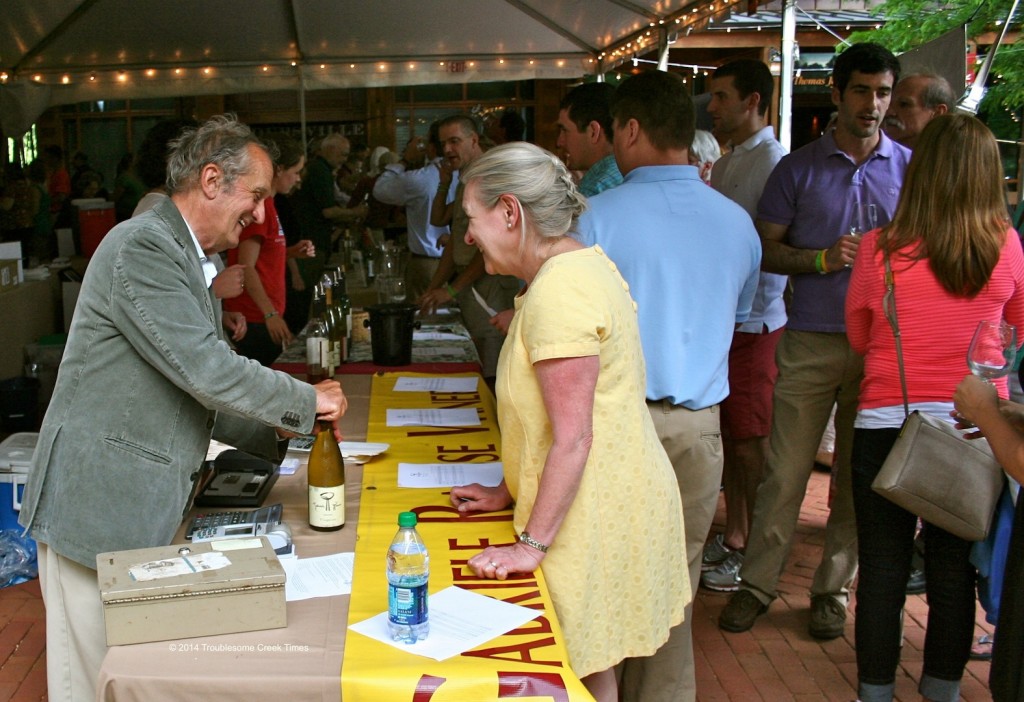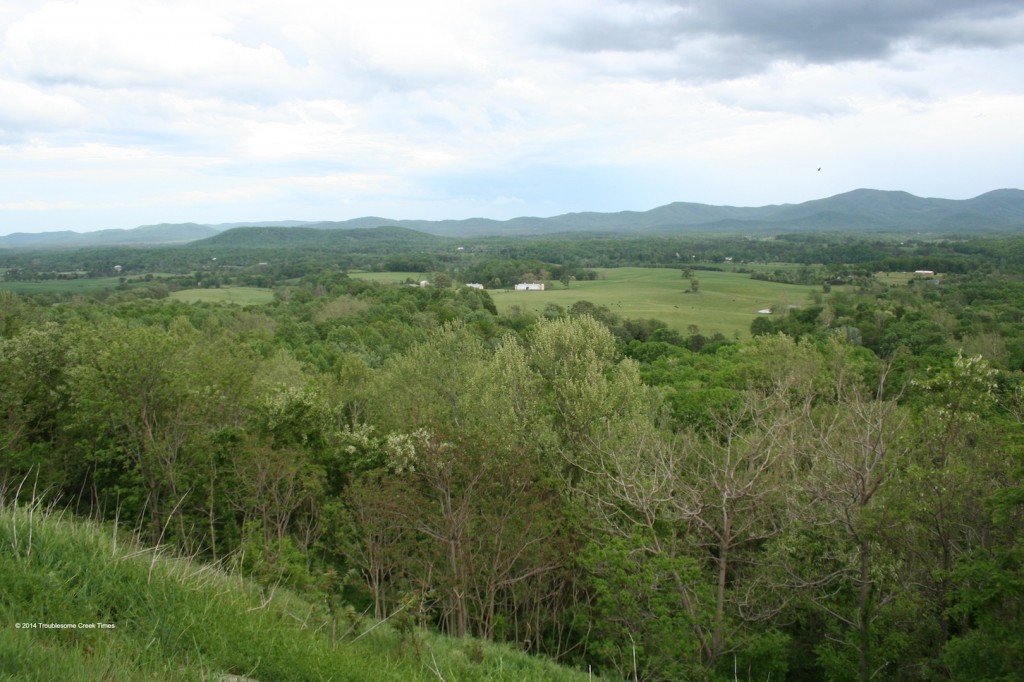By Jordan Thomas Hall
The beautiful Shenandoah Valley of Virginia was the center of my travel last weekend. One of the largest antique shows in this part of the country was being held there with excellent offerings. Also in the Valley is Thomas Jefferson’s home, Monticello. Touring the masterpiece I was able to learn a lot about Jefferson and enjoyed a wine festival held there that evening.
Series continued from last week. . .
Following a nice antique show in Fishersville, there was more to see in the Valley that day.
My girlfriend Morgan and I journeyed toward Charlottesville, stopping at a scenic overlook to admire the gorgeous Shenandoah Mountains. It’s not clear where the mountains get their name but all accounts seem to believe it has Native American origins. Driving into the forested hills we came upon Michie Tavern, an 18th century inn that served travelers, as well as being the center of the social affairs in the region. Today, it is open as a lunch buffet pleasingly dedicated to preserving 18th century way of life.
Minutes later we were in the large, scenic, layered parking lot of Monticello. We walked to the front ticket booth and were soon met by Mary Blair Zakaib of the public relations department. Mary, as well as the rest of the staff at Monticello, is exceptional with down-to-earth professionalism.
In the fertile lands of the Shenandoah Valley, a great wine industry has flourished. Being held that evening was Monticello’s third annual Wine Festival. The tremendous event brought ten of the region’s finest wineries for a tasting of their best vintages.
The first booth was among the best of show, Barboursville Vineyards. Winemaker Luca Paschina and his assistant proudly displayed and announced their offerings before dispensing a small amount in our wine glasses. I was instantly transported into the 2006 film Sideways, which features identical tasting scenes.
We were started off with white wines in the classic Chardonnay and the Virginia staple Viognier, both from their 2013 harvest. The next offering was a golden beauty in a slender bottle. The Malvaxia Passito (2008) was a wonderful dessert wine that I was instantly attracted to (and bought). Its smooth, consistent taste was prominent in apricot with notes of pineapple and pear and possessing an immensely pleasing aroma.
Red wines were offered next, beginning with the powerful, heavy Barbera (2012). Next was the pleasing Cabernet Franc (2011), a gold medal winner. The final offering was the most talked about wine at the event- their gold medal-winning Octagon. The merlot-based dark red wine, named after Jefferson’s architectural design, was complex but with a smooth finish.
Owner Lynn Davis of Flying Fox Vineyard in nearby Afton, Virginia featured four of her wines. The smooth Viognier was presented first followed by the sweet, dry Rose´, the complex but smooth Trio, and finishing with the medium-weight American-style Fox Red Table Wine (2011) with a great aroma.
All tasting booths were crowded and Gabriele Rausse’s was no exception. The Italian-born winemaker serves as Director of Gardens and Grounds at Monticello and produces wine there under his own label. Thomas Jefferson long-wanted to have his own thriving vineyard at Monticello and Rausse has spent years bringing to light Jefferson’s vision.
“The beautiful thing is to have Virginia producing wine,” said Rausse. “This is something Thomas Jefferson wanted to do. He came back from France with hopes of starting a wine industry in America. Why did he fail? He didn’t have the time to focus on the wine.
“But he could see so far (into the future). In my culture, wine is what you drink with your meal. It’s not to get high; it’s part of our diet. Jefferson said ‘wine is good for my health’ and (promoting temperance to prevent a drunken nation) said drink wine instead of heavy alcohol.”
Thomas Jefferson’s love for wine stemmed from his travels across Europe and its many vineyards. He persuaded Italian viticulturist Philip Mazzei to settle near his home in Virginia so that he might help to introduce winemaking to America. In spring of 1771 Jefferson planted his first grapes and later established a small vineyard on the south slope of Monticello. However, the slope yielded little results—until now. Rausse is overseeing two vineyards on the south slope. He has planted 20 of the 24 varieties Jefferson planted in 1807, mostly European grapes with French origins and American.
Rausse explains that wine in Jefferson’s time would have tasted weaker than those of today. The reason is sulfur dioxide, the additive used in wine. The sulfites protect wine from spoilage by bacteria and oxidation, and also help to reduce the volatile acidity. It is naturally produced by yeast, but that’s often not enough and more sulfur dioxide is added to bring it up to 30 ppm (parts per million). The moment the chemistry is off, the wine doesn’t taste right. In Jefferson’s day it was all guessing and intuition.
“The ‘winemakers’ figured out that by blending Sangiovese with Trebbiano the wine was better…they didn’t know why, but it was better,” says Rausse. “The answer is that when Sangiovese is ripe the pH can be around 3.9 (which is a dangerously high pH). When Sangiovese is ripe Trebbiano is still unripe (pH 3.00). If you blend the two, you correct the pH and you have a wonderful wine. I love the fact that Thomas Jefferson planted Sangiovese…but also Trebbiano.
“When Jefferson was in Italy he wrote of tasting a wine called ‘Montferrat’ which was ‘thick and strong’. The thick quality is likely an indication of bacteria. When he tasted the Nebbiolo, also in Italy, he said that ‘it was as sweet as silky Madeira, as astringent on the palate as Bordeaux, and ask brisk as Champagne’. The fact that he compared the wine with Madeira is a sign that the wine was clearly oxidated due to a lack of sulfites. The silky character could be a positive characteristic, but in excess could be a sign of bacteria as well. The brisk quality indicates that the wine had re-fermented in the bottle because the sulfites did not exist or were not at the proper level. So you can see at that time drinking wine was a real adventure.”
But there was still a thirst to know more about Jefferson and a visit to his beloved home was next.
Series continued next week.
Find the Troublesome Creek Times at local stores in Knott and surrounding counties or subscribe to the Times at (606)-785-5134

Winemaker Gabriele Rausse (left) uncorks a bottle of his vintage Viognier for participants of Monticello’s third annual Wine Festival. (Photo by Jordan Thomas Hall)
